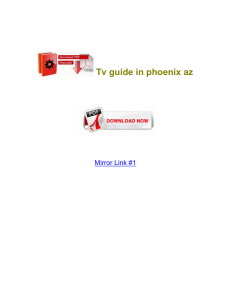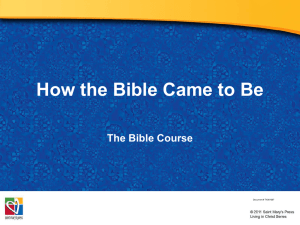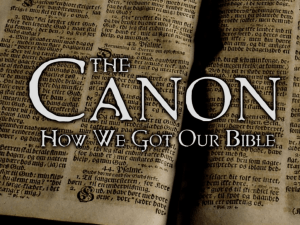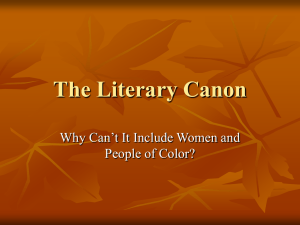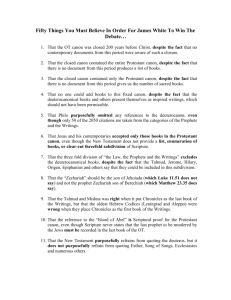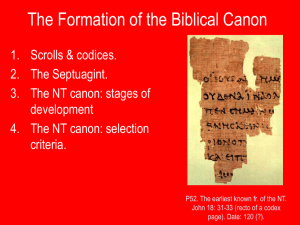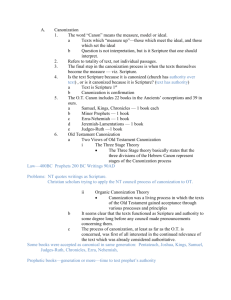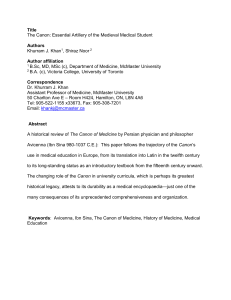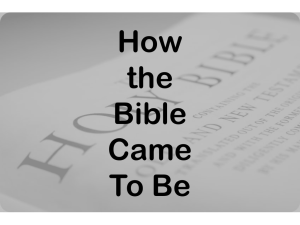Canon - Berachah Bible Church
advertisement
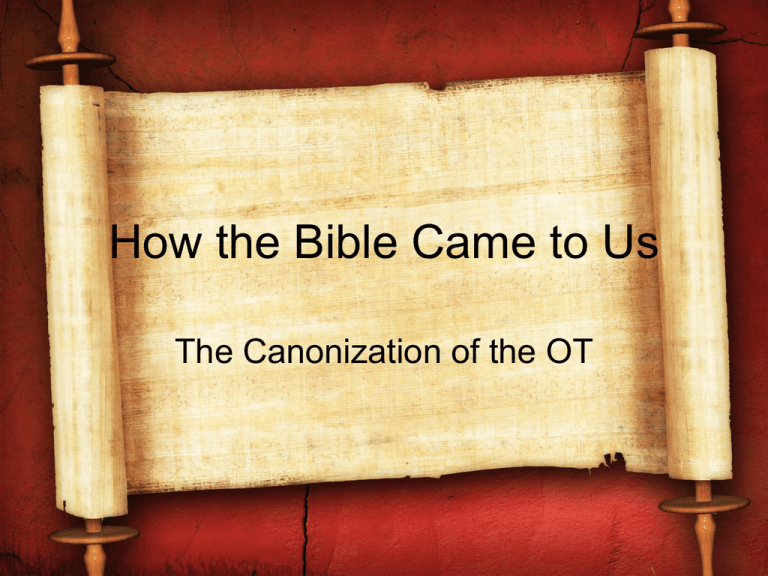
How the Bible Came to Us The Canonization of the OT Review • • • • • The Bible as the Word of God The Birth of the Bible Overview of the OT Overview of the NT Introduction to Text Types and the Unity of the Bible The Canonization of the OT • The Jewish people preserved the writings of the prophets because they believed them to come directly from God. • This is standard practice for any major world religion. • It is important to note that these books did not receive their authority because they were placed in the canon; rather, they were recognized as having intrinsic authority and were therefore included in the canon. – Keep in mind that the various books of the OT came into being over a period of some 1400 years. Definition of Canonization • Canon refers to a collection or list of books that are accepted as an authoritative rule of faith and practice. – The word is derived from a Greek word (kanw,n) that refers to any type of standard or guideline. – The term later came to mean a list of books which were regarded as authoritative. – Some books were more readily accepted than others. Designations of the OT Canon • The earliest reference to the OT as “the (Most) Holy Scriptures or Writings” (grafa,i) appears in the works of Philo (c. 20 B.C. – A.D. 50). • Josephus, writing about A.D. 90-100, refers to these works as i`erw/n bi,blwn, “sacred books” and noted the scrupulous accuracy with which they were copied. • It is clear that by NT times the OT canon (“the Law, the Prophets, and the Writings”) was established and revered by the Jews, and subsequently by Christians, as revelation from God. Formation of the OT Canon • There is still a great deal of uncertainty about this process. • The earliest transmission of biblical materials was probably oral. – At some point they were committed to writing to ensure accuracy. – The stone tables containing the Ten Commandments and the Law of Moses were among the earliest written documents. • Daniel 9:2 is one of the earliest references to a sacred collection of prophetic writings: – “...in the first year of his [Darius’] reign I, Daniel, observed in the books the number of the years which was revealed as the word of the LORD to Jeremiah the prophet for the completion of the desolations of Jerusalem, namely, seventy years.” Formation of the OT Canon • There is some evidence that after the destruction of Solomon’s temple in 586 B.C., there was a new emphasis on the collection and study of Scripture. • Jewish tradition recognized that prophecy had ceased after the ministry of Malachi in about 400 B.C., yet the writings of the prophets remained through the intertestamental period. Formation of the OT Canon • “In all its essentials the canon was most probably complete by about 300 B.C., and while discussion concerning certain component parts was continued well into the Christian era, the substance of the canon as it existed a century and a half after the time of Ezra and Nehemiah remained unaffected by these controversies” (R. K. Harrison, Introduction to the Old Testament, 287). Two Views of the Canon • Protestant – The church recognized the biblical books as inspired texts. – The Bible as God’s Word created the church. – The Bible alone is inspired. – Revelation has ceased. – The Apocrypha is not accepted as inspired. • Roman Catholic – The church authorized the Bible. – The church created the Bible. – The Bible and church tradition are authoritative. – Revelation is continuing. – The Apocrypha is accepted. Evidence for a Closed OT Canon • Evidence for a closed OT canon by the second century B.C. comes from several sources: – The LXX (250 – 100 B.C.) – The earliest extant mss from the 4th and 5th century do include some apocryphal books, but these may have been added to the canonical books. – Prologue to Ecclesiasticus (132 B.C) – refers to Hebrew Bible by “the law, the prophets, and the others that followed them.” – NT (45 to 95 A.D.) – Jesus uses the common tripartite division (Luke 24:44). NT writers quote from almost all of the OT books. – Josephus, Origen, Jerome, and other external sources confirm a 22 (or 24) book Hebrew canon matching the 39 books in our English Bibles. Continuing Questions Regarding the OT Canon • At the Council of Jamnia in A.D. 90, questions arose regarding the canonicity of five OT books: – Ezekiel • Issues: Ezek 40-48 seemed to contradict the Pentateuch; temple dimensions did not match up with any historical temple. • Resolution: issues were matter of interpretation rather than inspiration. – Proverbs • Issue: Certain proverbs were self-contradictory (e.g. Prov. 26:4-5). • Resolution: sometimes it is better to keep silent, sometimes a fool must be rebuked. Again, interpretation is the issue, not inspiration. Continuing Questions Regarding the OT Canon – Esther • Issues: Does not claim to be inspired; nowhere mentions the name of God; mentions the feast of Purim, a festival not mentioned in the Pentateuch. • Resolution: God’s providence, if not His name, is very conspicuous in the book. He delivered His people; ruled canonical. – Ecclesiastes • Issues: Man’s wisdom, not God’s; too pessimistic and skeptical. • Resolution: remained in the canon, and rightfully so. Continuing Questions Regarding the OT Canon • Song of Songs – Issue: graphic description of sexual love. – Resolution: interpreted allegorically as God’s love for Israel or Christ’s love for the Church. Remained in Canon. Canons for Canonicity • Though there are no explicit scriptural statements that provide tests for canonicity, the following criteria have been suggested for a book to pass: – It does not contain contradictions. – It was written by a prophet or someone recognized as having divine authority. – It originated through inspiration from God (“The word of the Lord came” or “Thus says the Lord”). – It was recognized and accepted by the Jews as authoritative material. Next Time: The Canonization of the NT
